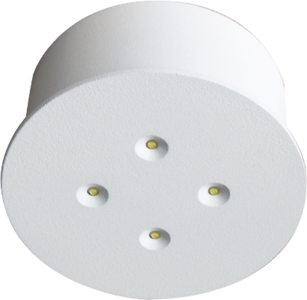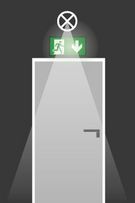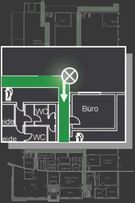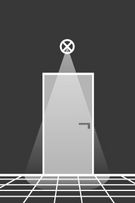
Standards and laws
On this page we want to give you some assistance to cope with the jungle of standards and laws about emergency and safety lighting.
With these topics you will find links to actual requirements, declarations to applicable standards and further information.
Because standardisation is subject to a steady review process, also this page will be updated reguarly to keep you up to date as well.
What is emergency lighting?
According to DIN VDE 0100-560 3.1 the emergency lighting counts to the electrical devices for security purposes. It takes place after the failure of the artificial lighting in a building for a defined time.
As a power source for safety purposes battery supplied systems, generators and a second network supply can be used.
In the battery supplied system it is distinguished between emergency lighting, self-contained and centrally supplied emergency lighting.
Self-contained emergency lighting
The luminaire is supplied by battery, which is installed in or close (max. 1m) to the luminaire housing. All required electrical devices such as charger, test- and monitoring devices, control unit and network identification are installed in the luminaire.
Emergency lighting with central battery supply
All emergency luminaires are supplied by a central battery set close to the central battery system. The electrical devices are installed in the controlling device. For battery supplied systems it is distinguished between the supply of a fire compartment or a fire compartment overall supply.
Protection target of the safety lighting is:
- To guarantee the safe leaving of a building in case of a general power failure
- Finding emergency escape routes easily
- Enable to find fire fighting and safety installations (eg. First aid post)
This includes:
- Marking and lighting of emergency escape routes
- Enabling rescue operations
Which type of emergency lighting does exist?
Escape sign luminaire
- Emergency sign luminaires indicate the way to the closest exit
- Marking a meeting point, from which you are guided away in case of an emergency
- For every change of directions there is a new luminaire
- Emergency sings are switched continuously (exception: work place)
- Emergency signs need to be recognisable in case of an emergency and cannot be blocked
Safety lighting
- Safety lighting is responsible for the illumination of escape routes
- Anti-panic lighting
- Places with high danger
- Emergency escape routes, stairs/ level changes and potential danger places need to be illuminated
- Illuminating first-aid facilities and fire-fighting and signaling devices
- Places with danger 10% of the required luminous intensity, minimum 15lx
- Non-maintained lighting or switched lighting
When is emergency lighting necessary?
The following links include the most important laws and standards about the necessity and conditions for safety lighting:
Working conditions rights
Technical rules for ordinances
[IS Argebau|www.is-argebau.de] - Musterbauordnung November 2012
Building law:
| Federal state | Building law | Abbreviation | State | Link |
|---|---|---|---|---|
BW Baden-Württemberg | Federal state building regualtion for Baden-Württemberg | LBO | 01.03.2015 | |
BA Bavaria | Bavarian building regulation | BayBO | 17.11.2014 | |
BE Berlin | Building regulation for Berlin | BauO Bln | 29.06.2011 | |
BB Brandenburg | Brandenburgian building regulation | BbgBO | 06.04.2010 | |
HB Bremen | Federal state building regulation for Bremen | BremLBO | 06.10.2009 | |
HH Hamburg | Building regulation for Hamburg | HBauO | 28.01.2014 | |
HE Hessen | Building regulation for Hessen | HBO | 15.12.2011 | |
MV Mecklenburg-Vorpommern | Federal state building regulation for Mecklenburg-Vorpommern | LBauO M-V | 20.05.2011 | |
NI Lower Saxony | Building regulation for Lower Saxony | NBauO | 23.07.2014 | |
NRW North-Rhine-Westphalia | Federal state building regulation of North-Rhine-Westphalia | BauO NRW | 01.03.2000 | |
RP Rheinland-Pfalz | Building regulation of Rheinland-Pfalz | LBauO | 09.03.2011 | |
SL Saarland | Federal state building regulation of Saarland | LBO | 11.12.2012 | |
SN Saxony | Building regulation for Saxony | SächsBO | 01.05.2014 | |
SA Saxony-Anhalt | Building regulation for Saxony-Anhalt | BauO LSA | 10.09.2013 | |
SH Schleswig-Holstein | Federal state building regulation | LBO | 22.01.2009 | |
TH Thuringia | Building regulation | ThürBO | 13.03.2014 |
How does emergency lighting need to be installed and operated?
Electrical Standards
- EN 60598-1, 10/15
- EN 60598-2.22, 06/15*
- DIN EN 50171, 11/01
- EN 50172, 01/05
- DIN V VDE V 0108-100, 08/10
- DIN EN 50272-2, 12/01
- DIN VDE 0100-560, 10/13
- DIN VDE 0100-710, 10/12
Building supervisory guidelines
- (M)LAR*, 03/00 + 11/05 + 02/15
- EltBauVO*, 01/09 und älter
* Paying attention to the introduction state in the relevant federal state
Lighting standards
- EN 1838, 10/13
- DIN 4844-1, 06/12
- DIN 4844-2, 12/12
- DIN ISO 3864-1, 06/12
- DIN EN ISO 7010, 10/12
Occupational health and safety law
- ASR A3.4/7, 07/17
Special directives/-standards:
- Directive for the building of baths, 2002
- Sports complex lighting, 04/08
- BGR/GUV-R 108, 06/09 Status 06/11
Which requirements does the safety lighting need to meet?
Overview about the requirements concerning the electrical device for safety lighting acc. to DIN V VDE V 0108 from 08/10 and DIN VDE 0100-560 from 10/13
| Examples for communal facilities | Illumination level, lx | Changeover time max. | Rated service time , h | Escape sign luminaire in permanent use | Central Power Supply System |
|---|---|---|---|---|---|
| Assembly facilities/- rooms | 1 | 1 | 3 | X | X |
| Exhibition halls | 1 | 1 | 3 | X | X |
| Theatre, cinema | 1 | 1 | 3 | X | X |
| Sales rooms | 1 | 1 | 3 | X | X |
| Restaurants | 1 | 1 | 3 | X | X |
| Medical rooms / Areas in hospitals/ practices/ Treatment centre/-facilities/ Spa treatment/ Therapy Centres/-Facilities and more | 1 | 15 f) | 24 e) | X | X |
| Hotels, guest houses, accomodation, homes | 1 | 15 a) | 8 d) | X | X |
| Skyscraper | 1 | 15 a) | 3 c) | X | X |
| Schools | 1 | 15 a) | 3 | X | X |
| Car parks | 1 | 15 | 1 | X | X |
| Escape routes at working places | 1 | 15 | 1 | 0 | X |
| Working places with particular risk / particular risk areas | ≥15 | 0,5 | b) | 0 | X |
| Stages | 3 | 1 | 3 | X | X |
| Airports, station | 1 | 1 | 3 g) | X | X |
| Examples for communal facilities | Power supply system with power limit | Single battery system | Power generation unit without interruption (0s) | Power generation unit with short interruption(max. 0,5s) | Power generation unit with med. interruptions (max. 15s) | Dual system/ separate supply |
|---|---|---|---|---|---|---|
| Assembly facilities/-rooms | X | X | X | X | - | - |
| Exhibition halls | X | X | X | X | - | - |
| Theatre, cinema | X | X | X | X | - | - |
| Sales rooms | X | X | X | X | - | - |
| Gaststätten | X | X | X | X | ||
| Medical rooms/ Areas in hospitals/ practices/ Treatment centre/-facilities/Spa treatment/ Therapy Centres/- Facilities and more | X | X | X | X | X | - |
| Hotels, guest houses, accomodation, homes | X | X | X | X | X | - |
| Skyscraper | X | X | X | X | X | - |
| Schools | X | X | X | X | X | - |
| Car parks | X | X | X | X | X | - |
| Escape routes at working places | X | X | X | X | X | X |
| Working places with particular risk/ Particular risk areas | X | X | X | X | - | X |
| Stages | X | X | X | X | - | - |
| Airports, Stations | X | X | X | X | - | - |
Legend:
X allowed
- not allowed
0 not required
a) Depending on the risk of panic of 1s to 5s and the risk assessment.
b) The time period with the threat for people.
c) In houses 8h, if the switch is not operated according to 4.4.8 .
d) 3h are enough, if switching according to DIN V VDE V 0108-100 from 08/10, Pkt. 4.4.8.
e) 3h are enough, if the medical need and use in the medical area are finished and the building can be evacuated within 3 h.
f) Depending on classification of the medical used room ≤ 0,5s bis ≤ 15s (see DIN VDE 0100-710 from 10/12 Anhang B)
g) For overground areas of stations 1h is allowed depending on the evacuation concept.
| Type of lighting | Required illuminance | Uniformity (Emin/Emax) | Rated service time | Existence of Emin (*1) |
|---|---|---|---|---|
| Safety lighting of escape routes: | 1lx (*3) on the centre line of the escape route | 1:40 | At least 1h. | 50% of E min in 5s, 100% in 60s |
| Safety lighting for working places with particular potential risks: | 10 % of the general lighting, at least 15lx (*3) | 1:10 | The rated service time has to be the same as the period of danger for the people.(*2) | The required illuminance has to exist constantly or reached in 0,5s |
| Anti-panic lighting: | At least 0,5lx (*3) on the free floor area | 1:40 | At least 1h. | 50% of E min in von 5s ;100% in 60s |
(*1) on german workplaces acc. ASR A3.4/3 in 15s.
(*2) Evaluation is the task of the operator.
(*3) measuring plane ≤ 2cm over the floor.
Lighting requirements
*1 max. 2m distance in the horizontal
*2 vertical illuminance 5 lx
Sample policies for fire protection classifications of the cable system ([M]LAR)
| Land | (M)LAR Stand 03/2000 eingeführt | (M)LAR Stand 11/2005 eingeführt |
|---|---|---|
| Baden-Württemberg | Nov 06 | |
| Bavaria | Jan 08 | |
| Brandenburg | Dez 06 | |
| Bremen | Jan 07 | |
| Hamburg | Jan 07 | |
| Hessen | Dez 06 | |
| Mecklenburg-Vorpommern | Aug 06 | |
| Lower Saxony | Feb 07 | |
| North Rhine-Westphalia | Aug 01 (the 1600m² for fire compartments do not apply) | |
| Rhineland-Palatinate | Nov 06 | |
| Saarland | Apr 08 | |
| Saxony | Jun 06 | |
| Saxony-Anhalt | Feb 07 | |
| Schleswig-Holstein | Mai 07 | |
| Thuringia | Aug 07 |
Tests and inspection periods
Inspection period acc. toDIN V VDE V 0108-100 and sample inspection order
Initial inspection
- Measuring of the lighting values of the safety lighting acc. to DIN 5035-6 and EN 1838.
- Initial inspection acc. to DIN VDE 0100-600.
- Inspection of ventilation and exhausting of the installation room for batteries and the associated facilities acc. to EN 50272-2 (VDE 0510-2).
Daily inspection*
- Presenting the central power supply device on the correct function at the device, or at a clearly visible location via meldetableau or observation system
Weekly inspection *
- Function test of the safety lighting by adding the emergency power supply (for battery supplied systemes) including function test of all connected luminaires.
- When using automatic test systemes these have to accord to EN 62034 (VDE 0711-400).
Monthly inspection *
- Additionally to weekly tests the correctsystem of the observation devices of the central battery system has to be tested.
- Please keep ISO 8528-12 und DIN 6280-13 in mind for the generator set.
Yearly inspection *
- The yearly inspections can just be initiated manually.
- In addition to the monthly inspection all luminaires of the safety lighting have to be tested on their fully, necessary duration.
- Test of all luminaires according to the existence, cleanliness and right function of their safety lighting.
- Generators acc. requirements of ISO 8528-12 and DIN 6280-13.
- Test of batteries and their operating conditions acc. to EN 50272-2 (VDE 0510-2).
- Inspection of the charging device.
At least every three years *
- Measuring the lighting values of the safety lighting acc. to EN 1838.
- Repeating inspections of the safety lighting via legally recognised expert from the Federal State Building Order.
*The date and the result of the inspection have to be documented in the logbook of the system.
Who is authorised to execute inspections, service and restorations?
- Authorized persons (euP) acc. to DIN VDE 0105-100 from 10/09 and DIN VDE 1000-10 from 01/09
- Electrician acc. to DIN VDE 0105-100 from 10/09 and DIN VDE 1000-10 from 01/09
- qualified person acc. to BetrSichV from 09/02, status 11/11 and TRBS 1203 from 03/10, status 02/12
- registered inspector acc. to MPrüfVO from 03/11 and DIN V VDE V 0108-100 from 08/10
Further information
DKE:
German Commisssion for Electrical, Electronic & Information Technologies of DIN and VDE. The DKE is the German organisation responsible for the elaboration of standard, guidelines and safety requirements for the field of electronic and electrical engineering and information technology.
Website: https://www.dke.de
ZVEI:
German Electric and Electronic Manufacturers' Association represents the economic-, technological - and ecological interests of the medium-sized electrical industry.
Website: http://www.zvei.org/
licht.wissen:
The publication series bundles the complete knowledge of the lighting sector in 20 titles by now. In every edition you find many examples from real life, information concerning lighting technological fundamentals and find out, which lamps and luminaires suits best for which application.
http://www.licht.de/de/service-info/publikationen-und-downloads/heftreihe-lichtwissen/
licht.forum:
Pursuing writing about general, actual and practical themes all about lighting. Published by licht.de.
http://www.licht.de/de/service-info/publikationen-und-downloads/sonstige-lichtde-schriften/
















